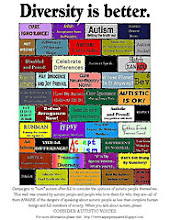The Theory of mind and other minor irritations - don't cry for Pluto, who still has chums
I do not like the "Theory of Mind." A few years ago I'd never heard of it and didn't know what it was. With the arrival of a couple of autistics chaps in our family, I rapidly became aware of this pernicious irritation. For current purposes, we may simply say that it is an inability to put yourself in the shoes of another. [
I would respectfully guide you to a more scholarly account of the dratted theory at
"a bfh"
as I believe that I know [a few of] my limitations.]
It is a very popular theory with experts. I suspect, but have no evidence in support, that it is not quite so popular in other pockets of the population. The hot bed of loathing against this theory, resides right here, within the four walls of my home. I see the 'truth' of the theory often, daily. But I also see the opposite. "What exactly is the opposite of the 'theory of mind,'" you ask? Good question as always. Frankly I don't have the right answer. I don't know what you call it [offers gratefully received] but I know it when I see it, and I see it often, more often, and soon, perhaps more often that I see incidents of the Theory of mind. I am seriously considering adopting 'opposites day,' everyday, where instead of looking for 'symptoms' we will search for 'the opposite' to counter each and every one of them.
Round here, such issues are complicated by the speech delay factor. How can I know that my child is capable of viewing the world through someone else's eyes, if he is unable to tell me that this is what he is seeing? Well, if I pay attention, as I sometimes do, they do have other ways of telling me: body language, mimicry, action.
Now that the speech delays are less so than they once were, I only wish I had paid more attention, or had been better at interpreting what they were trying to communicate by other means.
That aside, I am appreciative of the small acts of kindness that the average child bestows upon the world, seemingly with little effort, to melt the heart of a parent.
It's true, I'm biased and not a scientist. I leave such cerebral exercises to the experts. I'm just a mum, so I'm allowed to make up my own rules. But I do not think that should detract from similar moments displayed by an autistic child. Indeed, lets be totally outrageous and posit that the theory, that autistic children, in many respects, outstrip the limitations of the Theory of Mind with their superior qualities of empathy.
Without digressing into the staggering powers of Temple Grandin in this respect, we can still find many incidents of this phenomenon, in our own autistic children. Not for them the scripted stagnant waters of 'I'm sorry you hurt your knee,' together with appropriate facial expression and body language. Oh no, we soar to un-recognised heights of concordance, where little Sally, Boa, Arcadio, Adarsh, Jerzy, Kona and Muhammed, together with their pals from across the globe, acknowledge that Pluto may be too small to be a planet in today's universe, but that the books that once held truth do not necessarily lie, just because somebody changed the rules.
p.s. Here is a picture of my daughter's plant grown from seed at school. A long tendril comes out to slip round my son's asthma inhaler chamber and then further forward to entwine my soap dispenser gizmo.
First of all, they both notice the tendril and where it's heading. Junior, who has excessive washing tendencies, remarks that 'maybe the plant needs more air.' My older son, with asthma, remarks that 'maybe the plant wants to wash.'
O.k. so I admit it, I've indoctrinated my children with respect to the environment, my lesson plan obviously needs a little tweaking, but who is in whose shoes now! Pass me my slippers before I confuse myself any further.





2 comments:
Thanks for the link... I suspect scientists often make up their own rules too, but they think no one will notice because they are scientists!
a legume likes to support itself, and uses its tendrils to gain that support. if there is more moisture and nutrients at that location, then it might sprout "roots" there too.
the tendrils help it to "climb" up towards the highest concentration of light.
Post a Comment